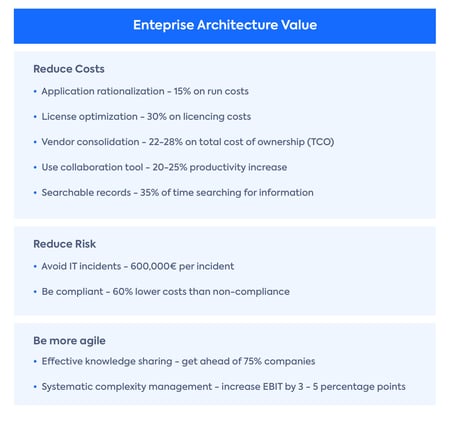Introduction
Enterprise Architecture is a discipline that aligns the complex business and IT structures within large-scale organizations. It is a strategic and technical role that introduces practical standards across departmental units.
The goal: streamlining processes, analyzing current trends in technology architecture, and making sure that IT strategy is aligned with the organization’s mission.

The 7 key use cases of Enterprise Architecture
What is the value of enterprise architecture?
The value of enterprise architecture comes from establishing solutions to organization-wide problems. It’s a role that supports businesses in becoming more agile and meeting strategic goals by working towards a cohesive, company-wide technology landscape. It is a role that has the most overarching view of an organization’s IT landscape.
Thus, it fully understands the core business needs and how to improve processes.
The value of enterprise architecture is best seen through improvement in data management, application development, IT infrastructure, business processes, and overall organizational impact.
 Quantitative estimation of EA values
Quantitative estimation of EA values
The following paragraphs lay out the key value of enterprise architecture, and why it’s such a vital role for modern organizations.
📚 2023 Gartner® Magic Quadrant™ for Enterprise Architecture Tools
1. Improved alignment of IT with business goals
Enterprise architecture supports or leads business strategies to improve processes and optimize the IT landscape. This means that the EA will have a comprehensive overview of the application landscape, business processes, and information flows between departments.
By improving the alignment between IT and business, EAs can analyze various sources of information to solve unplanned or future problems in enterprise landscapes.
This could be anything from IT upkeep and maintenance, overseeing software migration, optimizing vital business processes, or maintaining an awareness of industry-relevant technology to help the company remain competitive.
2. Increased efficiency and effectiveness
One of the main reasons to optimize and align the IT landscape with business processes is to increase the efficiency and effectiveness of important organization-wide processes. This will impact the organization as a whole, and provide a solid groundwork for continuous optimization efforts.
Part of the way EAs do this is by implementing vital tools and collaborative platforms. These allow them to understand and analyze the business architecture. Tools allow EAs to identify business needs, collect data, research solutions, define plans and measure results. All this is important so the EA can achieve its target state architecture.
The LeanIX Enterprise Architecture tool is a software that provides actionable dashboards and can create reports for many different stakeholders. This enables them to continuously and collaboratively transform the business.
The LeanIX Enterprise Architecture helps EAs identify and eliminate redundant applications, systems, and processes with the goal of reducing costs and increasing efficiency, among many other benefits.
3. Enhanced agility
Another major value of enterprise architecture is that it will enable business agility throughout the organization. It’s important to note that this is not the same as Agile software development. Business agility is a separate concept that helps organizations react effectively to changing markets and customer environments.
In layman's terms, EA and business agility allow companies to move with fewer constraints, helping them to implement strategic change simply and effectively.
Increased agility helps businesses become competitive by increasing responsiveness to consumer needs, providing better positioning to deal with ongoing and constant change, and redeploying resources effectively, to name a few.
4. Better decision-making
Enterprise architecture supports better decision-making. It does this by providing company leaders with clear data and insights into the structure of the business so that decisions can be made quickly and effectively — even under pressure.
Breakdowns in information and data tend to stem from a lack of transparency and unclear access to information. This creates technological clutter, bottlenecks, and bad information sharing between platforms and domains.
What EA provides is a clear overview of an organization’s digital workings so that decision-making becomes easier and more agile. This adds greater value and transparency to both business and IT, improves flexibility, answers critical business questions, and provides data-driven insights and visualizations which support the organization’s strategy and goals.
5. Improved governance
Another value of enterprise architecture is improved governance. EA governance encompasses all elements of business management. For example, EA governance involves firm leadership, complete knowledge of an organization's structure, a clear strategic direction, and enabling effective IT processes to achieve an enterprise’s goals.
The primary objective of EA governance is to harmonize the architectural requirements of an enterprise into a straightforward set of policies, processes, and procedures — all of which help ensure the organization’s vision and align its standards with real-life business requirements.
EA governance can help organizations achieve significant cost savings, improve architectural coherence, and overcome challenges through greater transparency and accountability. In addition, it can also uncover areas of improvement to determine true best practices.
[READ ON BELOW]


 Quantitative estimation of EA values
Quantitative estimation of EA values



![How to Answer the Top Questions of Enterprise Architecture Stakeholders [Poster]: Align business and IT and learn how to support each of their needs. »](https://no-cache.hubspot.com/cta/default/2570476/9bf74c6d-ebaf-41f4-ac30-0a0282b2fe43.png)
